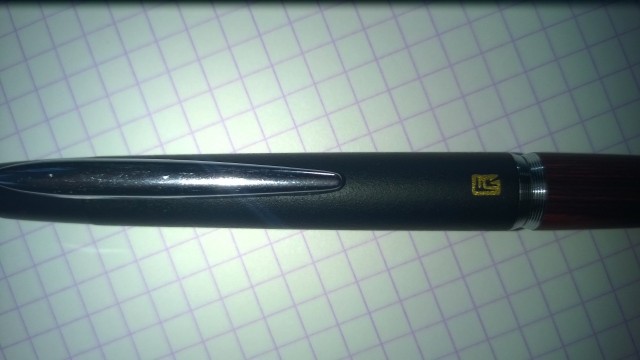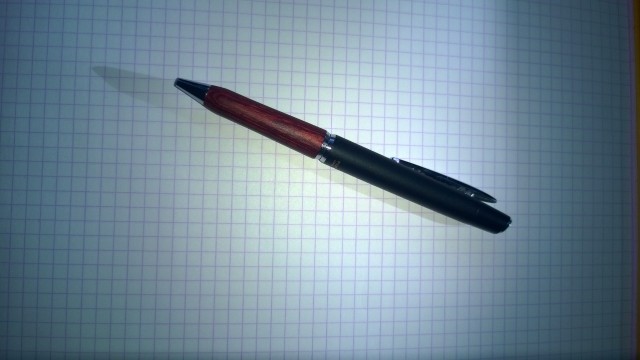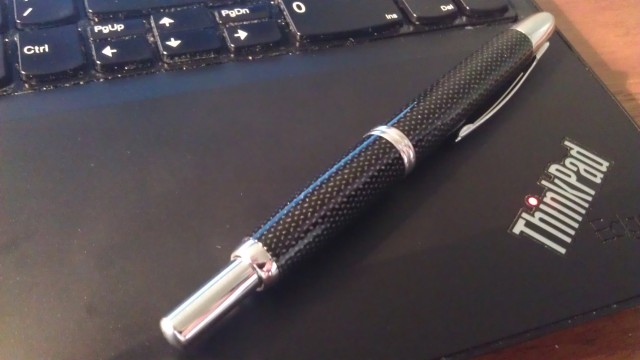Found on a Weekday Lunch Hour
“Why aren’t these sold in the United States?” I asked the older Japanese woman behind the pen and stationery counter in New York City’s midtown Kinokuniya bookstore. I was holding a Pilot Fumi Raku ballpoint in nanbutetsu (“southern iron”), whose barrel resembled the texture of a cast-iron tea kettle, its grip made of bright red briarwood. The combination was uniquely, immediately attractive, by sight and sensation.
She replied quietly and politely. “I believe they are too small, and they do not weigh enough. Americans like big pens, heavy pens.”
I’m the impulsive owner of a Pilot Knight that feels like a dead-brass mistake every time I hold it — I could empathize with her observation. Heavy pens bring to mind thoughtless gifts, items that you’re meant to receive but never use. The Fumi Raku felt like a counterargument to that, right in my hand — light and balanced, fit. I felt like I was being let in on a secret.
Not From Around Here
In that, I haven’t been proven wrong about the secret part, at least for Americans: though images of these pens abound, Pilot Fumi Raku’s are all but impossible to buy online, with the exception of through Rakuten, that ubiquitous middleman for direct-from-Japan dealers. To have no authorized US distribution is a shame, in my opinion, because the Pilot Fumi Raku is one of the most remarkably high-quality, high-value (though not inexpensive) pens I’ve ever come across.

The Fumi Raku logo, which no other Pilot pen seems to carry. Zoom in to see that it’s actually the English letters combined.
Pictures, in this, case, do a modicum of justice. The Fumi Raku embodies hyper-modern, yet somehow timeless aesthetic. Textures are immediately pleasing and the visual contrast of matte barrel to brilliant metal trim are in all the right places. It’s a genuinely unique design.
There’s a thought-outedness to nearly everything about the Fumi Raku. The refill is accessed from a joint rendered all but invisible within the metal trim. The clip acts spring-loaded though from what I see it’s likely a single piece of metal, and the clipping action is among the strongest, yet easiest I’ve ever encountered. The pen is balanced and proportionate in hand.

Another close up of the symbol side. The briarwood grip is a pleasure to hold. The pen separates at the metal that splits the section from the barrel.
Writing is done by oil-based Pilot BRFM-30 refills (BRFM-10 refills in a finer point are also available): they are simply the most reliable, smoothest, best-writing ballpoint unit I’ve ever used. Write tiny, write loopy, write on nearly any kind of paper, including slick-coated receipts that give my Lamy ballpoints fits — these Pilot refills can do it all.
From visual inspection of both refills, Pilot’s Dr. Grip refills, widely available, seem to be the same size and may work in a pinch.
The Fumi Raku, In Use
The day of that conversation at Kinokuniys, I left with the nanbutetsu. If there’s a single regret I have about adding the Fumio Raku to my collection, the lack of a fountain pen to match must be it. However I’ve found that a certain kind of Bauhaus complements perfectly…

The common with the uncommon – Pilot Fumi Raku with an XF Lamy 2000. A go-to travel pair for me, as the Pilot will write on nearly any paper, and the Lamy can write for up to five days on one fill
Not long afterward, I bought the Touki (“pottery”) in white with an oak barrel, to match yet another Lam from my collection —

I don’t have the camera to show it, but there are subtle, circumferential striations in the white barrel. I think this echoes the swirls in wet clay which eventually result in a clay pot…
Intending another German-Japanese alliance (a terrible pun, I know)…

The pair that will never be – a Lamy CP1 PT with the Pilot Fumi Raku in Touki. The “threading” of the metal in the PIlot complements the ribbing of the Lamy body almost uncannily
However, my wife, not someone not usually in thrall to pens, soon appropriated the Touki for her journal writing. For her, the pen is a perfect combination of striking to look at, pleasurable to hold and easy to use.
And in fact, wherever I’ve used the Fumi Raku, sharp eyes have always spotted it and admired. If ever in New York City, Kinokuniya is definitely worth a stop. And the Pilot Fumi Raku is definitely a pen worth trying, and buying, when there.












